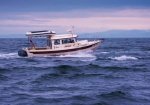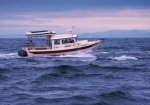-->"• Steer the waves: Learn how to best snake your way through the wave pattern. A little well-timed helm input can make for a much smoother ride. Each boat and sea state are different, so again practice is important."
I would say that most anything in this paragraph after this bit, needs to be taken with a pound or two of salt. Most of it will fit well with the authors, a licensed captain and owner of 3 boats, vessels, but much of it does not apply to our nearly flat bottomed boats. For instance:
"...Typically, hulls with less beam and more deadrise will handle the rough stuff better than designs with wider, flatter bottoms."
His statements are qualified with
"but this depends in large part on the boat’s characteristics."
For our C-Dorys this part is good advice: "You might want to consider a zigzag course, “powerboat tacking” if you will." which may be on every wave, depending on the size, type (breaking or not), and wind direction, (with or against the current). Often running parallel in the trough with beam seas can work but it is imperative to keep an eye on the oncoming wave and know when to jog over into the next trough. (called the Jog and Slog running style).
The paragraph on "Decreased speed" mentions
"It is essential to remain in control of your vessel, (Dah, good point!! Emphasis mine.), and at reduced speed, there is more time to maneuver and react to seas. Also, the boat may fall into displacement mode so that more of it is in the water, improving stability."
He is speaking of high deadrise vessels and considering our C-Dorys will maintain plane at 9 or 10 knots, we have more steerage control at that speed than if we drop into displacement speed. We do not gain stability at displacement, and for running beam seas, that is a huge disadvantage for us. In head seas, speed is dependent on the wave steepness as in following seas. This is where there is frequent throttle work, to avoid slamming, and in following seas to avoid any bow steering, trim tabs must be in full up position, and tail heavy is a plus. the author does have a reminder in closing,
"Keep in mind, however, that there is a point where too little speed can hamper maneuverability."
Best advice. Be cautious, and carefully try some marginal conditions, where you can get out into some sea way and then back without committing to a 25 mile crossing in gale conditions.
Learning from experience is great, especially if it can come from other peoples experience, but that does not give you experience, so..... go get some, carefully.
Harvey
SleepyC :moon



